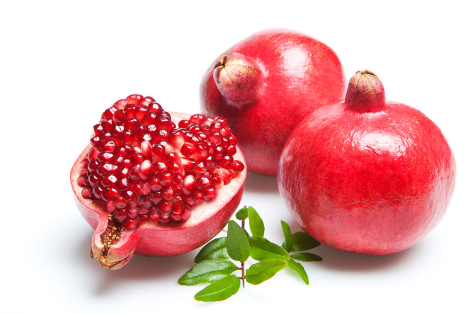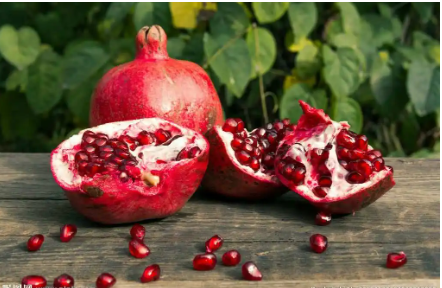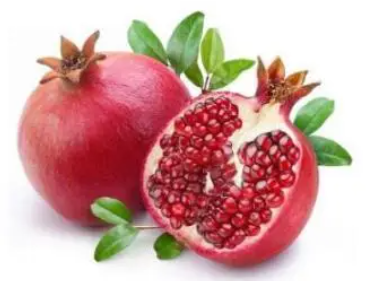Pomegranate is a plant of the Pomegranate family, native to Central Asia in the Himalayan region of Persia, including present-day Iran, Afghanistan, and other countries. It was introduced to China through the Silk Road by Zhang Qian of the Han Dynasty (1-2 centuries BC) over 2000 years ago. At present, it is distributed throughout China. Pomegranates have been known as "crystal pearls and jade" since ancient times, and are listed as precious fruits. They are also loved by people for their sour and sweet taste, cool nature, and rich nutritional content, as well as their extensive therapeutic effects.

01
The nutritional value of pomegranate
Pomegranate is known as a unique fruit in the world and a famous fruit in Kyushu. Its fruit is rich in carbohydrates, proteins, various amino acids, and essential trace elements and vitamins for the human body. The edible part of pomegranate accounts for about 15% to 40%, with a moisture content of about 78.2%. When immature, there is more sucrose, and when mature, there is more converted sugar, with a total sugar content of 11% to 16.8%. Pomegranate contains malic acid and citric acid, and its sour taste varies depending on the variety and maturity of the fruit. The general content is 0.4% to 1.0%, with an average of 0.77%. Pomegranate contains abundant vitamins and mineral substances, with 0.01mg of carotene per 100g of juice VB1,0.0 4mg .VB2,0.0 9 rag .V p p,1.7 rag.VC,4.6~11mg, Calcium 11-13rag, phosphorus 11-16rag, iron 0.4-1.6mg, as well as relatively abundant potassium, copper, manganese, zinc, etc. It also contains 0.6% to 1.5% protein, 0.6% to 1.6% fat, and 2.7% crude fiber. Pomegranate is full of treasures throughout its body, and its chemical components vary in different parts. Flavonoids, tannins, alkaloids, organic acids, and special structured polyphenols are distributed differently in fruit juice, peel, leaves, and bark; Pomegranate seeds and other parts often contain steroids, phospholipids, triglycerides, and other components.

02
The processing technology of pomegranate food
1. Processing of pomegranate juice beverage
1.1 Process flow Raw material selection, cleaning, trimming, crushing, beating, heat treatment, filtration, blending, deoxygenation, filling, sealing, sterilization, cooling, labeling, and finished product 1.2 Key points of operation
(1) Raw material selection: The fruit should be fresh and plump, 90% to fully ripe, free from decay, pests, diseases, and mechanical damage, with a diameter of at least 40mm. (2) Cleaning and trimming: Qualified fruits should be rinsed with clean water, and then the stem and sepals should be removed with a stainless steel knife. (3) Crushing and beating: In order to facilitate beating, the fruit is first crushed, and then water is added in a 1:1 ratio for beating with a colloid mill. (4) Heat treatment: Heat the above slurry to 80 ℃ and maintain it for 10 minutes, which can cause partial pectin decomposition protein to undergo thermal denaturation and coagulation, and also passivate the activity of polyphenol oxidase. After heat treatment, nutrients are easy to dissolve and the juice extraction rate is high. (5) Filtering: First, use 4 layers of gauze for coarse filtration, then filter with nylon cloth. After multiple rounds of filtration, obtain the original pomegranate juice. (6) Mixing: According to the requirements for the original juice content and taste of fruit juice beverages, mix the original juice content, sugar, and acidity. The finished product requires a sugar content of 12%, an acidity of 0.2%, and a raw juice content of 20%. Meanwhile, add 0.1% sodium alginate as a stabilizer. Sugar and acid are directly added to the mixing tank, heated and dissolved, and then mixed with the original juice, drinking water, etc. (7) Degassing: Heat the prepared product to 60-70 ℃, degas for 5 minutes, and then homogenize it with a colloid mill. (8) Filling and sterilization: First, wash and disinfect a 250ml glass bottle, then fill the prepared beverage and seal it with a crown capping machine. Put the sterilizer into a high-temperature sterilizer for sterilization, with a sterilization formula of 5-lOmin/110 ℃, and cool it in stages with cold water to room temperature. This product is milky white, slightly cloudy, without layering or precipitation, with a rich pomegranate aroma, soluble solids of 12%, and an acid content of 0.2%.

2. Processing of pomegranate ice cream
2.1 Process flow: 2.2 Key points of operation (1) Preparation of pomegranate pulp: Pomegranate fruits are first selected to remove rotten, overripe, and damaged fruits. Then rinse thoroughly with clean water, adding detergent such as sodium 2-ethylhexanesulfonate or sodium lauryl sulfonate to the cleaning water. Thoroughly rinse off the cleaning agent with clean water, and after cleaning, roughly crush the fruit. Then, use a beater to beat and separate the seeds and pulp. The fruit pulp is ground by colloid, which can crush the cells, refine the fruit grains, improve the tissue of the original pulp, and produce the original fruit pulp. It can be used in a timely manner or refrigerated for later use. The pomegranate pulp that needs to be stored must be quickly cooled to -18 ℃ and stored cold at this temperature. To avoid loss of color, aroma, taste, and Vitamin C during storage, as well as spoilage during thawing, antioxidants need to be added when the fruit is crushed, and some sugar and antioxidants (SO2 can be selected) need to be added when beating the pulp. This type of pulp can be used It is necessary to use a vacuum short-term evaporation process to remove SO2. (2) Mixing and aging of raw materials: Mix the stabilizer with 10 times the weight of sugar evenly, then add water and dissolve for later use. Mix skim milk powder or whole milk powder, light condensed milk and cream with an appropriate amount of water, then add the melted cream and prepared stabilizer. Mix the remaining sugar and fruit pulp together, heat to 65 ℃, put them into a homogenizer, and homogenize. After particle refinement, it is sterilized at 80 ℃ for 20 minutes and placed in an aging cylinder. The temperature is lowered to 4 ℃ and stirred for 4-6 hours to enhance the hydration effect of the raw materials; Reduce the temperature from 4 ° C to 2 ° C, age for 6 to 1 hour, stir slowly to fully combine the material and liquid, and eat without ice crystals. (3) Freezing, filling, and storage: When freezing at 0-4 ℃, it is necessary to regularly check the freezing condition, adjust the stirring speed in a timely manner, maintain an appropriate expansion rate, and coordinate with the filling speed. After freezing, it is filled and placed in a -18 ℃ -20 ℃ freezer or cold storage for refrigeration, resulting in hard ice cream. Pomegranate fresh fruit ice cream should maintain a constant temperature during cold storage, with a storage period of no more than 3 months, and it is best to sell it in a timely manner. 2.3 Process formula
137g of whole milk powder, 85g of condensed milk, 85g of cream, 53g of sugar, 18g of egg, 3g of sodium alginate, 2g of monoglyceride, 200g of pomegranate fruit pulp, and 417g of water.

3. Processing of pomegranate health vinegar
3.1 Process flow: 3.2 Key points of operation (1) Fruit selection, fruit washing, and peeling: Pomegranate fruits used for vinegar production must be fully ripe, free from pests and diseases, and free from mold and spoilage; Wash off impurities and dust on the surface of the fruit to reduce contamination of the finished product; Hand peeling can also be done mechanically, and the pomegranate seeds can be crushed. (2) Sugar soaking: Mix sucrose with crushed pomegranate seeds in a ratio of 1.2-1:1, one layer of pomegranate seeds and one layer of sugar, and place them in porcelain, enamel vessels, or immersion tanks. Seal to prevent aroma from escaping and soak for 6-10 days. (3) Filter and extract juice: Filter and separate pomegranate seeds and their extracts with gauze to obtain pomegranate sweetened juice, with soluble solids ranging from 65% to 70%. The pomegranate seeds from the separated mountains can be used to extract flavonoids and other substances. (4) Dilution: Mix the original juice with 4 times the weight of cold water to form a diluted pomegranate juice with soluble solids of about 16% to 18%. (5) Alcohol fermentation: Pour the diluted pomegranate juice into the fermentation tank. Add the original juice to 4/5 of the fermentation tank, leaving a space of 1/5 to prevent the liquid from overflowing outside the tank during fermentation. Add 5% to 7% yeast for cultivation and stir evenly. Control the temperature to around 25 ℃ for alcohol fermentation. The entire alcohol fermentation process takes about a week to complete, with an alcohol content of around 7%. In order to grasp the changes in the fermentation process, it is necessary to regularly check the sugar, acid, and alcohol content of the fermentation broth, and pay attention to sealing the pool mouth to reduce the evaporation of alcohol. (6) Acetic acid fermentation: Add 1/3 of the fermented pomegranate juice to the mother liquor of acetic acid bacteria for acetic acid fermentation. The fermentation temperature should be controlled at around 30 ℃, and fermentation should be carried out under dark conditions. In the early stage of fermentation, it is advisable to stir once a day to increase the oxygen content in the fermentation broth. After about 10 days, when the total acidity no longer increases and the alcohol content is trace, it is called pomegranate vinegar. (7) Aging: Transfer pomegranate vinegar to a large vat and seal it for 2-3 months. During the aging process, a series of physical and chemical changes occur in the vinegar, causing the color of pomegranate vinegar to darken, the aroma to be strong, the taste to be soft and mellow, the concentration to increase, and the quality to be further improved. (8) Preparation: Add 2% salt and 0.08% potassium sorbate to the aged pomegranate vinegar, and adjust the acidity and other indicators according to the standard. (9) Filtering: Filter out the sediment in pomegranate vinegar to ensure its clarity and transparency. (10) Sterilization: Using an instantaneous sterilization machine for sterilization, the sterilization temperature is around 90 ℃, and the time is 15 seconds. Pomegranate vinegar can also be boiled and sterilized before bottling while it is hot. (11) Bottle inspection: The sterilized vinegar is bottled and sealed, and after passing the sampling inspection, it is considered a finished product. 3.3 Process parameters Alcohol fermentation: initial sugar content 180B x, initial acidity pH 4.2, fermentation temperature 25 ℃, fermentation time 8 days; Acetic acid fermentation: fermentation temperature is 30 ℃, fermentation time is 10 days, initial acidity is 1.4%, and alcohol content is 7%.
Shaanxi Huike Botanical Development Co., Ltd. a integrated enterprise which is focus on natural products, Plant extract related products and services.We mainly focus on pharmaceutical, functional food, Freeze-dried powder,Natural Pigment,Homology of medicine and food,beverages and other business services.
For more information about inulin, please contact us!
Email:marketing@huikes.com
2024-05-27
Shaanxi Huike Botanical Development Co., Ltd.






